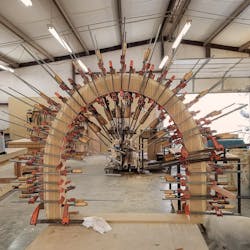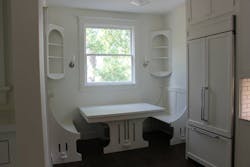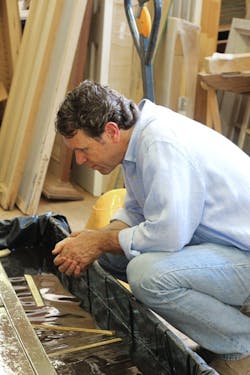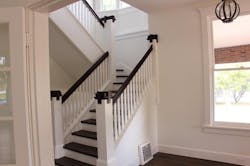"When I design a home in the classical style, I’m playing with a language. I’m writing poetry,” Brent Hull tells me. We’re sitting in his office, a cheerfully disheveled space filled with old books and intriguing objects that I want to ask about, but not right now. That’s because Hull is “on a soapbox” as he calls it, and the power of his words has my full attention.
“I get the comment that my ideas are great for discussion but don’t actually work out,” he says. “I call BS on that. I’ve been doing this for over 20 years and it does work.”
“This” is what Hull calls “timeless building.” He’s the founder of Hull Historical, in Fort Worth, Texas, a contracting company that focuses on restoration and high-end construction. He’s also one of the nation’s foremost experts on historical millwork and has written two books on the topic. Yet, rather than focus on wonkish recitations of the egg and dart pattern’s many forms, Hull’s approach is to also look at millwork through the lens of human experience, examining how it reflects our cultural assumptions, economy, and value system at any given moment.
His most recent book, Building a Timeless House in an Instant Age (Brown Books, 2014), makes a passionate case that the houses we build define us as a country, and that by abandoning quality in favor of the “instant home,” we are becoming a culture “that has no ability to gauge beauty or value.”
Hull is 6 feet 4 inches with a friendly farmer face, high forehead, and intensely blue eyes. He walks through the world with an effortless authority that goes beyond “tall, confident white guy” and into the realm where true leaders live. When Hull talks about his twin passions of design and craftsmanship, he lights up like a country house at night, a place so simple and true that your feet can’t help but walk up the dark road toward it. That light supplies him with clients who open their wallets with complete trust. That light got him his own reality TV show.
To listen to Hull talk, as I did for most of a day, is to build new synapses between ideas that are seemingly unrelated: the golden rectangle, technology, American culture, the number of plumbing fixtures on the market, entablature, and craft beer to name a few. Yet in that matrix, there are three core concepts that he returns to again and again; concepts that reflect a slow but palpable shift that’s taking place in the way we imagine our homes. The first of those ideas—that a house is a narrative—informs the other two, which concern the role of classical architecture and a new movement toward higher quality, more sustainable construction.
The Middle Ground
Hull grew up in Dallas and attended Baylor University with a major in history and English. But his first love was always working with his hands. After college, he went on to study preservation carpentry at the iconic North Bennet Street School, in Boston, one of the few institutions in the U.S. that still teaches the art of craftsmanship in disciplines from bookbinding to violin making.
“At Bennet Street I learned museum-quality historic restoration,” Hull says. “If we built a door, we did it with hand planes so that there were marks on the wood.”
Shortly after graduating, Hull opened his company, working out of his brother’s garage and taking on any projects he could get. Slowly, the preservation jobs began to come, a train depot here, a courthouse there, until today he does more than $10 million in revenue per year, with another $2.5 million from a separate millwork business. Hull Historical may be the most respected authority on restoration in Texas and is one of just a few leaders in the field nationwide.
Hull separates remodeling into three categories: museum-quality restoration, preservation restoration, and renovation. “Less than 1 percent of the work we do is museum-quality,” he says. “Renovation is just some contractor putting in the latest stuff, cheap and fast. That middle ground is really where you’re making decisions. … [Maybe] you want new stuff, but the feel of an old house, and you’re trying to find a blend. That side of the spectrum adds more long-term value.”
That message is slowly beginning to resonate with homeowners, and today Hull’s skills are very much in demand. In 2016, to keep pace with his growing millwork business, he purchased a cabinet company and moved his operation to more spacious digs—a 22,000-square-foot facility outside of Fort Worth. And then Hollywood came calling. In October, the History Channel debuted a new reality show starring Hull (and his Labrador, Romeo) as he noodles around Texas restoring cool old things.
House as Narrative
A house is the physical embodiment of the culture that created it. It’s like an oversize Rorschach test that clearly communicates the values of owner, builder, and designer. That’s why the remnants of ancient dwellings are so important to archaeologists who can often read the DNA of a whole society based on nothing but ghosted stone outlines and a bit of flooring.
Within that context of home as cultural metaphor lies one of Hull’s core messages: the importance of what he calls a “timeless house.” A timeless house isn’t cheap, trendy, or disjointed. Instead, it’s built to last, and all the components, down to the plumbing fixtures, work collectively to weave a cohesive narrative.
“The pursuit of a timeless house is really a pursuit of education, understanding, and refinement,” Hull says. “The goal is not just to put molding on a wall. The goal is to create a space that is magical, to build rooms and a home that beckon you.”
With that, I have a question: “What about if you’re restoring an old house and the client wants modifications that go against the original structure?” I ask. “What if they want to tear down all the interior walls and create a large, open-concept floor plan?”
“That would be insensitive,” Hull says, his tone urgent and personal, as if we weren’t talking about a theoretical house at all, but an actual person, a grandfather, maybe, frail on his feet and much beloved, and I had suggested that we betray him in some way.
So, how to avoid rudely imposing a great room on a 100-year-old farmhouse? In older floor plans, the relationship between the primary living spaces often makes sense, and a better solution would be to open a few walls and widen cased openings to improve the flow, Hull says. Sometimes there are also past remodeling projects to contend with—we’ve all seen the bolted-on, shoebox additions—and that prior work can obscure a home’s true narrative. In those cases, the best approach may be to demo past misdeeds and start from scratch.
“You can design a great room addition so that it complements the architecture of the house,” Hull says. You can work with the scale of the room so that it blends and is harmonious. You can do it so well that people won’t even know you added on. The goal is to be sensitive to the original.” This skill is especially valuable today, as homeowners continue to desire spacious multipurpose areas for family living.
Classical Design
The story of how humans build shelter starts from the first dwellings before recorded time and progresses to the modern, suburban subdivisions of today.
The story has multiple turning points, like a novel, and one of the most significant of these developments occurred in ancient Greece and Rome. A tradition of building that celebrated balance and proportion began in about the sixth century B.C.E. and spread throughout the Roman Empire, influencing architecture for the next two millennia. The Greeks were inspired by the physical beauty of the human form, as well as its function. Columns, doorways, windows, and other elements were continuously studied and refined in the pursuit of designs that were in harmony with nature and the human body.
“Just as the finger is proportionate to the hand, the hand to the arm, and the arm to the body, so too in the classical tradition of building, the parts are proportionate to the whole,” Hull says. “Naturally, we instinctively relate to it—it’s the reason some old buildings just feel right.”
The birth of modernism in the 20th century changed the way Americans look at their houses. Design was streamlined and anything ornamental that pulled at the eye was stripped away as if it created drag. Today, the overwhelming majority of designers are solely trained as modernists and the musical precision of classical architecture is no longer seriously taught outside of history classes. Indeed, across more than 130 architecture schools in the U.S., only one (the University of Notre Dame) has a program dedicated to traditional architecture and urbanism.
This divorce from the past has resulted in generations of architects who don’t really understand the principles of classicism. “The thing that I dislike about modernism today and that whole academic culture is that it’s anti anything that isn’t modern,” Hull says. “Looking at classicism is a worthwhile conversation that would benefit modern design. There are a lot of modern things that are fabulous, but there’s got to be a balance. And I don’t think that’s happening.”
The lack of attention to classicism has made the timeless house much more rare. Hull uses the example of homes that are assembled with a mishmash of styles placed like stickers on their façades—“French” or maybe “Tudor”—without a unifying underlying philosophy.
“I’m involved with the Institute of Classical Architecture & Art, and we’re trying to get onto a campus and just teach some of these concepts,” Hull says. “The opposition we’re getting is venomous. From [the university's’] point of view, I’m just rehashing the past, but there’s so much to be learned from the past. … I’m using those ideals as a way to express something new today.”
The Movement Toward Craft
Yet there are bright spots. The past few years have brought a cultural shift, and Americans are now embracing the ideals of artisanal craft and manufacturing. The guy with ironic facial hair making small-batch cheeses in a loft downtown may be a cliché, but he’s also a driving force in multiple markets.
The principles behind the craft movement—high quality, locally sourced products, sustainability, and social responsibility—have affected myriad industries, including home building and remodeling.
“I look at our culture and the Millennials who work for me,” Hull says. “They like craft coffee, they like craft beer. They don’t drink Budweiser or Miller. It’s cheap! Why would I drink a crappy beer?” His voice rises, his face filled with a windswept kind of intensity, and I can see the preacher on the mountain, the iron-colored sky.
“There’s a culture shift taking place,” Hull says. “The anti-McMansion movement is an example, and people are really looking at the whole disposable thing … this game where you can sell [a badly built house] and let it be someone else’s problem.”
Indeed, the additional cash that buyers are willing to spend for a supersize home has dropped by as much as 84 percent in some markets, according to real estate website Trulia. That premium has also dropped in 85 of the top 100 housing markets.
And then there’s McMansionhell.com. The website is the brainchild of Kate Wagner, a 22-year-old graduate student and architecture aficionado. Using architectural principles, humor, and a generous helping of snark, Wagner highlights exactly what’s wrong with these homes. The site struck a chord and went viral this summer. Wagner’s basic point echoes one of Hull’s: No one really likes McMansions, but often they can’t articulate why. Her analysis provides that vocabulary.
Hull compares the rise of the artisanal movement to the end of the Victorian Age in architecture. During the late 1800s, homes were vigorously competing for who could have the grandest entrance, the finest turrets, the most elaborate trim. Victorian houses mixed styles and historical periods so that you might find Italianate, Queen Anne, and Gothic Revival elements all jammed onto the same façade.
“What followed the Victorian period?” Hull asks and immediately answers his own question. “The Arts and Crafts movement! It was a complete rejection of everything Victorian. Instead of having ornamentation, it was like, ‘Simplify this thing. I want honest, I want true construction.’ That was what the whole movement was about: The machine has stolen our soul, and we need it back. It’s similar to what’s happening today. You have the McMansions—gaudy things, cheap, cheap, cheap, basically a tract house on steroids—and people are looking at them now and saying, ‘I don’t want that.’”
I picture one of the old Victorian houses that sits in my neighborhood, drafty, half haunted, and think about the builder who no doubt took pride in creating that audacious statement of wealth. Barely 100 years later his home is viewed not with awe, but with bemused tolerance. Will McMansions be preserved? Do postmodern homes have staying power? What will sit on their ruins?
“This is a profession that goes back thousands of years,” Hull says. “And there are guys who’ve been practicing it for five and think, ‘Oh I can do that.’ No. To be a student of this profession and our trade is a big deal. It matters. What we build matters. Our homes define who we are, and that’s important.”
Almost 1,000 miles away from Brent Hull’s office, the team at Red Arrow Industries was searching for a new reality series to produce. Based in Knoxville, Tenn., the production company is the creative force behind an eclectic group of shows from Pumpkin Wars to Best Ever Treehouses.
When the development staff spotted Hull talking about historical columns on a YouTube video, they immediately thought he could be a fit.
“Brent has a way of delivering information so that you want to know more,” says Danny Downing, executive producer of Hull’s show, Lone Star Restoration, and co-owner of Red Arrow Industries. “He’s funny and entertaining and passionate about historical design. We wanted to make restoration appealing to a wider audience.”
The show debuted on Oct. 3, 2016, on the History Channel and is available on television and online. Although some creative license was taken with Hull’s life (he doesn’t just happen upon restoration jobs while driving to the store), the show is fast-paced, informative, and captures Hull’s enthusiasm for restoration.
“The message is to consider the past when designing,” Downing says. “Be deliberate and considerate. We want to inspire people to think before they do something to a historical home. It may sound naïve, but we’re hoping to create a show that facilitates some change in the way people think about building and remodeling.”
Lonestar Restoration follows in the footsteps of series such as American Restoration, Pawn Stars, and American Pickers, in that they’re all centered on a love of old things, but Hull is a little more message-driven.
A recent episode looks at how the use of hand tools can add precision to a carpentry project. Hull introduces the advantages of working with a low-angle block plane rather than sandpaper, and even calls attention to the beauty of the small wooden curls as they fall from the plane. “We are building products that last for hundreds of years,” he says, repeating one of his mantras.
Lonestar Restoration reminds us why we should care.
Here are some practical guidelines for remodeling contractors that will help any project become a timeless house.
Gain an understanding of classical architectural principles. Even for remodeling companies that only do contemporary work, it’s still important that designers learn traditional principles. These ancient concepts govern shape, proportion, and the relationship between different elements and can be used to inform any design. The classical tradition relies on the human body as its model, which is why many people believe that certain spaces just “feel right” when you enter them.
Develop a narrative with your client. When working with homeowners, Brent Hull helps them devise a sort of mission statement for the design. Capturing the project’s goals in a few clear sentences enables the client to stay focused, especially when it comes to product selection. “I’ve had clients describe ‘barefoot’ as a way of living,” Hull says. “I work with them. I tell them, ‘That sounds like you want a casual house, maybe wide-plank floors.’ That’s going to determine molding shape and materials.”Hone your craft. While it’s critically important to learn the principles behind classical design, those guidelines won’t make sense without clear examples. To that end, Hull recommends two books as indispensable for gaining best practices. Get Your House Right: Architectural Elements to Use & Avoid, by Marianne Cusato and Ben Pentreath (Sterling, 2008), offers a wealth of practical advice. The book highlights every element of home design with hundreds of drawings. Especially valuable are illustrations featuring two versions of the same component with an explanation of why one should be used and the other avoided.
Second on Hull’s must-read list is Traditional Construction Patterns: Design and Detail Rules-of-Thumb, by Steve Mouzon (McGraw-Hill, 2004). As with Cusato and Pentreath’s guide, Mouzon’s book provides clear explanations on the use—and misuse—of traditional elements. “Those two books are very helpful for understanding order, harmony, and building details,” Hull says. “If you just took those two and applied them to your process, [a lot of people in the remodeling industry] would prevent 80 percent of the problems they have.”
About the Author
Erika Mosse
Director of Content
Erika Mosse is the former director of content for Professional Remodeler.







